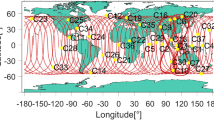Abstract
BeiDou regional navigation satellite system (BDS) also called BeiDou-2 has been in full operation since December 27, 2012. It consists of 14 satellites, including 5 satellites in Geostationary Orbit (GEO), 5 satellites in Inclined Geosynchronous Orbit (IGSO), and 4 satellites in Medium Earth Orbit (MEO). In this paper, its basic navigation and positioning performance are evaluated preliminarily by the real data collected in Beijing, including satellite visibility, Position Dilution of Precision (PDOP) value, the precision of code and carrier phase measurements, the accuracy of single point positioning and differential positioning and ambiguity resolution (AR) performance, which are also compared with those of GPS. It is shown that the precision of BDS code and carrier phase measurements are about 33 cm and 2 mm, respectively, which are comparable to those of GPS, and the accuracy of BDS single point positioning has satisfied the design requirement. The real-time kinematic positioning is also feasible by BDS alone in the opening condition, since its fixed rate and reliability of single-epoch dual-frequency AR is comparable to those of GPS. The accuracy of BDS carrier phase differential positioning is better than 1 cm for a very short baseline of 4.2 m and 3 cm for a short baseline of 8.2 km, which is on the same level with that of GPS. For the combined BDS and GPS, the fixed rate and reliability of single-epoch AR and the positioning accuracy are improved significantly. The accuracy of BDS/GPS carrier phase differential positioning is about 35 and 20 % better than that of GPS for two short baseline tests in this study. The accuracy of BDS code differential positioning is better than 2.5 m. However it is worse than that of GPS, which may result from large code multipath errors of BDS GEO satellite measurements.
Similar content being viewed by others
References
China Satellite Navigation Office. 2011. Development of BeiDou Navigation Satellite System. The 6th meeting of International Committee on GNSS
China Satellite Navigation Office. 2012. BeiDou Navigation Satellite System Signal In Space Interface Control Document Open Service Signal B1I (Version 1.0). December 2012
Gao W G, Jiao W H, Xiao Y, et al. 2011. An evaluation of the COMPASS Time System (BDT). J Navig, 64: S31–S39
Grelier T, Dantepal J, Delatour A, et al. 2007a. Initial observations and analysis of COMPASS MEO satellite signals. Inside GNSS, 2: 39–43
Grelier T, Ghion A, Dantepal J, et al. 2007b. COMPASS signal structure and first measurements. ION GNSS 20th international technical meeting of the Satellite Division. Fort Worth, TX. 3015–3024
Han C, Yang Y, Cai Z. 2011. BeiDou navigation satellite system and its timescales. Metrologia, 48: S213–S218
Hauschild A, Montenbruck O, Sleewaegen J M, et al. 2012. Characterization of COMPASS M-1 signals. GPS Solut, 16: 117–126
Hauschild A, Montenbruck O, Steigenberger P. 2013. Short-term analysis of GNSS clocks. GPS Solut, doi: 10.1007/s10291-012-0278-4
Li J L, Yang Y X, Xu J Y, et al. 2013. Performance analysis of singleepoch dual-frequency RTK by BeiDou navigation satellite system. In: Sun J D, Jiao W H, Wu H T, et al., eds. Proceedings of China Satellite Navigation Conference (CSNC) 2013. Lecture Notes in Electrical Engineering, 245: 133–143
Montenbruck O, Hauschild A, Steigenberger P, et al. 2013. Initial assessment of the COMPASS/BeiDou-2 regional navigation satellite system. GPS Solut, 17: 211–222
Shi C, Zhao Q, Hu Z, et al. 2013. Precise relative positioning using real tracking data from COMPASS GEO and IGSO satellites. GPS Solut, 17: 103–119
Teunissen P J G. 1993. Least-squares estimation of the integer GPS ambiguities. Invited lecture, section IV “Theory and Methodology”, IAG General Meeting. Beijing, China
Teunissen P J G. 1995. The least-squares ambiguity decorrelation adjustment: A method for fast GPS integer ambiguity estimation. J Geod, 70: 65–82
Yang Y X. 2010. Progress, contribution and challenges of COMPASS/BeiDou satellite navigation system. Acta Geodaet et Cartograph Sin, 39: 1–6
Yang Y X, Li J L, Xu J Y, et al. 2011a. Contribution of the COMPASS satellite navigation system to global PNT users. Chin Sci Bull, 56: 2813–2819
Yang Y X, Li J L, Xu J Y, et al. 2011b. Generalised DOPs with consideration of the influence function of signal-in-space errors. J Navig, 64: S3–S18
Author information
Authors and Affiliations
Corresponding authors
Rights and permissions
About this article
Cite this article
Yang, Y., Li, J., Wang, A. et al. Preliminary assessment of the navigation and positioning performance of BeiDou regional navigation satellite system. Sci. China Earth Sci. 57, 144–152 (2014). https://doi.org/10.1007/s11430-013-4769-0
Received:
Accepted:
Published:
Issue Date:
DOI: https://doi.org/10.1007/s11430-013-4769-0




